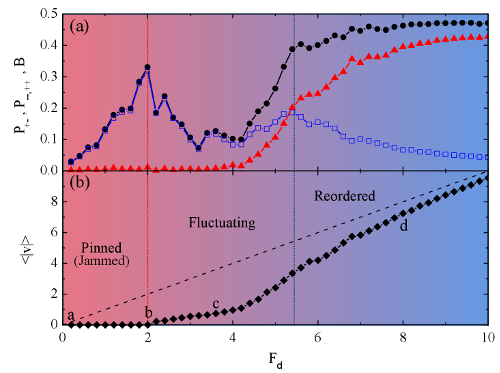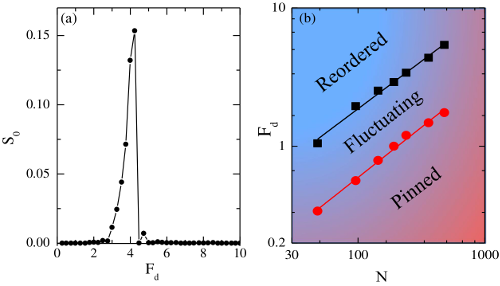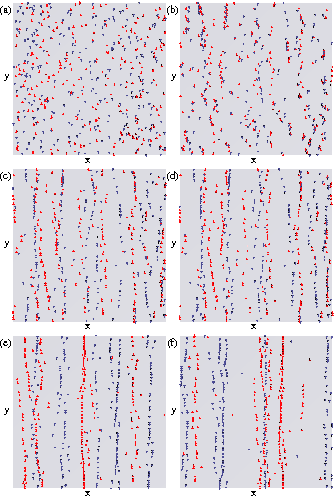Simulation
Results and Discussion
References
There are numerous examples of systems of collectively interacting particles that, when driven externally, depin and undergo dynamical pattern formation and/or dynamic phase transitions, such as a transition from a fluctuating to a nonfluctuating state. In these systems, which include domain walls, driven vortices in type-II superconductors [1,2,3,4,5,6], sliding charge density waves [7], and driven Wigner crystals [8], fluctuating and intermittent dynamics arise just above a plastic depinning transition when an applied external force is increased from zero. For higher drives the particles dynamically order into patterns such as anisotropic crystals or moving smectic phases with different types of fluctuation statistics [9,10,11,12,13]. Dislocations in materials are known to undergo a transition at the onset of irreversibility or yielding that has similarities to plastic depinning [15,14]; however, it is not known whether driven dislocations exhibit the general features associated with plastic depinning transitions. Establishing such a connection could potentially open a new understanding of driven dislocations. The potential connection between moving dislocations and plastic depinning models has been inspired by recent numerical studies for scaling near the yielding transition which fit to a mean field model for interface type depinning [16]. It is known that organized dislocation structures within individual crystals, such as walls or tangles, can become more refined and better defined as stress or strain increases. Two-dimensional (2D) and three-dimensional (3D) dislocation dynamics simulations based on linear elasticity theory predict self-organization of dislocation assemblies into varying configurations, such as pileups near the yielding or depinning transition [14,15,17], and 2D mobile walls [18,19] or 3D slip bands [20,21] under an external drive. Below a critical stress where dislocations show no net motion, the system is considered jammed or pinned [22,23,24], while intermittent or strongly fluctuating behavior with jerky or avalanche-like motion of the type proposed to be a signature of critical dynamics [18,19,26,27] occurs above the critical stress [18,25]. Here we demonstrate that driven dislocation assemblies exhibit a set of nonequilibrium phases similar to those observed for collectively interacting particle systems undergoing plastic depinning, including pattern organization in the pinned state, a strongly fluctuating intermittent phase with coexisting pinned and moving particles [1,3,10,28,29], and at higher drive, when the substrate effectiveness is reduced, a phase in which the dislocations organize into moving wall structures [2,3,4,6,7,11,12,13]. The onsets of these different dynamical regimes are correlated with pronounced changes in the transport curves [1,5], noise properties [3,30,31], and spatial structures [4,6,9], and can be observed via changes in the dislocation structure, mobility, velocity distribution, and velocity noise. Our work implies that many of the established results obtained for driven vortex and other systems can be used to understand dislocation dynamics.
Simulation
We utilize a discrete dislocation dynamics model for a 2D cross section of a sample with periodic boundary conditions containing N=480 straight edge dislocations that glide along parallel slip planes. We also tested systems with smaller values of N. This model was previously shown to capture the behavior observed in stressed anisotropic materials, such as intermittent flow near the onset of motion [22,23,24,18]. The periodic boundary conditions are of the same type that have been used previously to study intermittent dislocation flow in viscoplastic deformation [18], dislocation jamming and Andrade creep [19], and power-law relaxation of dislocation systems [32] An equal number of positive and negative dislocations are randomly placed in the sample and move in the positive or negative x-direction depending on the sign of their Burgers vector b. Out-of-glide plane motion is forbidden. To prevent in-plane pile-ups, we place at most one dislocation per plane. Rather than imposing an annihilation rule [15,18,19], we enforce that two adjacent glide planes must be separated by at least δy, where δy is on the order of the Burgers vector of the dislocations [22,23,24,32]. The dislocations interact via a long-range anisotropic stress field that is repulsive or attractive depending on their sign and relative angle. We utilize a replicated image model to efficiently simulate a large number of dislocations over long times [33]. Within the simulation volume, all dislocations are subject to the stress fields of all surrounding dislocations regardless of their position. To best make the connection with particle systems, nucleation of dislocations during loading is suppressed. Under an external applied stress τext, dislocation i moves along x in its assigned plane according to an overdamped equation of motion given by η[(dxi)/(dt)]=bi(∑j ≠ iN τint(rj−ri)−τext) where xi is the x coordinate of dislocation i at point ri=(xi,yi) with Burgers vector value bi, η is the effective friction, and τint(rj−ri) is the long-range shear stress on dislocation i generated by dislocation j. Here our time units are defined such that one simulation time step dt=10−6. The external load on a dislocation is proportional to the stress, Fd = bτext. For r=(x,y)=(xj,yj)−(xi,yi), τint(rj−ri) is τint(r)=bμ[x(x2−y2)]/[2π(1−ν)(x2+y2)2] where μ is the shear modulus and ν is the Poisson's ratio. The length of the square simulation cell L is set to unity and the simulation volume remains fixed throughout loading. In our normalized units, μb/2(1−ν)=1 and η = 1. We initially relax the system without an applied external drive, and then apply the external drive with small enough stress rate and sufficiently long waiting times τwait between increments to avoid transient effects. We measure the average absolute value of the dislocation velocities 〈|v|〉 = ∑i=1N〈|vi|〉, where vi=dxi/dt, as a function of the stress. This is analogous to the voltage versus applied current curve for superconducting vortices, and is the same as the dislocation collective speed defined in Refs. [16,22]. To characterize the dislocation content and charge of the wall structures, we use the pair-correlation distribution dx=|xi−xj|, the x-axis separation between two dislocations. The fraction of dislocation pairs with dx < w is Pw=ndx < w/ntot, where w is the pre-assigned maximum wall width, ntot is the total number of pairs, and ndx < w is the number of pairs with dx < w. We set w=0.05, although other reasonable values, such as w=0.02, give qualitatively similar results. To distinguish unipolar from dipolar walls, we discriminate between those pairs of like and unlike sign that lie within the critical wall width. We measure B = P++,-−P+−, where P++,- (P+−) is the fraction of pairs of like (unlike) sign. B is directly related to the net Burgers vector around one dislocation within the wall width w and P+− indicates the fraction of dipoles in the system. When a dipolar wall forms, B → 0 since P++,- ≈ P+−, while when a unipolar wall forms, P+−=0 and B=P++,-.Results and Discussion
References
- [1]
- Bhattacharya, S. & Higgins, M.J. Dynamics of a disordered flux line lattice. Phys. Rev. Lett. 70, 2617-2620 (1993).
- [2]
- Koshelev, A.E. & Vinokur, V.M. Dynamic melting of the vortex lattice. Phys. Rev. Lett. 73, 3580-3583 (1994).
- [3]
- Olson, C.J., Reichhardt, C. & Nori, F. Nonequilibrium dynamic phase diagram for vortex lattices. Phys. Rev. Lett. 81, 3757-3760 (1998).
- [4]
- Pardo, F., de la Cruz, F., Gammel, P., Bucher, E. & Bishop, D.J. Observation of smectic and moving-Bragg-glass phase in flowing vortex lattices. Nature (London) 396, 348-350 (1998).
- [5]
- Hellerqvist, M.C., Ephron, D., White, W.R., Beasley, M.R. & Kapitulnik, A. Vortex dynamics in two-dimensional amorphous Mo77Ge23 films. Phys. Rev. Lett. 76, 4022-4025 (1996).
- [6]
- Troyanovski, A.M., Aarts, J. & Kes, P.H. Collective and plastic vortex motion in superconductors at high flux densities. Nature (London) 399, 665-668 (1999).
- [7]
- Danneau, R. et al. Motional ordering of a charge-density wave in the sliding state. Phys. Rev. Lett. 89, 106404 (2002).
- [8]
- Reichhardt, C., Olson, C.J., Grønbech-Jensen, N. & Nori, F. Moving Wigner glasses and smectics: dynamics of disordered Wigner crystals. Phys. Rev. Lett. 86, 4354 (2001).
- [9]
- Yaron, U. et al. Structural evidence for a two-step process in the depinning of the superconducting flux-line lattice. Nature (London) 376, 753-755 (1995).
- [10]
- Faleski, M.C., Marchetti, M.C. & Middleton, A.A. Vortex dynamics and defects in simulated flux flow. Phys. Rev. B 54, 12427-12436 (1996).
- [11]
- Balents, L., Marchetti, M.C. & Radzihovsky, L. Nonequilibrium steady states of driven periodic media. Phys. Rev. B 57, 7705-7739 (1998).
- [12]
- Le Doussal, P. & Giamarchi, T. Moving glass theory of driven lattices with disorder. Phys. Rev. B 57, 11356-11403 (1998).
- [13]
- Moon, K., Scalettar, R.T. & Zimányi, G.T. Dynamical phases of driven vortex systems. Phys. Rev. Lett. 77, 2778-2781 (1996).
- [14]
- Moretti, P., Miguel, M.-C., Zaiser, M. & Zapperi, S. Depinning transition of dislocation assemblies: Pileups and low-angle grain boundaries. Phys. Rev. B 69, 214103 (2004).
- [15]
- Laurson, L., Miguel, M.-C. & Alava, M.J. Dynamical correlations near dislocation jamming. Phys. Rev. Lett. 105, 015501 (2010).
- [16]
- Tsekenis, G., Uhl, J.T., Goldenfeld, N. & Dahmen, K.A. Determination of the universality class of crystal plasticity. EPL 101, 36003 (2013).
- [17]
- Bakó, B., Weygand, D., Samaras, M., Hoffelner, W. & Zaiser, M. Dislocation depinning transition in a dispersion-strengthened steel. Phys. Rev. B 78, 144104 (2008).
- [18]
- Miguel, M.-C., Vespignani, A., Zapperi, S., Weiss, J. & Grasso, J.R. Intermittent dislocation flow in viscoplastic deformation. Nature (London) 410, 667-671 (2001).
- [19]
- Miguel, M.-C., Vespignani, A., Zaiser, M. & Zapperi, S. Dislocation jamming and Andrade creep. Phys. Rev. Lett. 89, 165501 (2002).
- [20]
- Csikor, F.F., Motz, C., Weygand, D., Zaiser, M. & Zapperi, S. Dislocation avalanches, strain bursts, and the problem of plastic forming at the micrometer scale. Science 318, 251-254 (2007).
- [21]
- Wang, Z.Q., Beyerlein, I.J. & LeSar, R. Slip band formation and mobile dislocation density generation in high rate deformation of single fcc crystals. Phil. Mag. 88, 1321-1343 (2008).
- [22]
- Tsekenis, G., Goldenfeld, N. & Dahmen, K.A. Dislocations jam at any density. Phys. Rev. Lett. 106, 105501 (2011).
- [23]
- Groma, I., Györgyi, G. & Ispanovity, P.D. Comment on "Dislocations jam at any density." Phys. Rev. Lett. 108, 269601 (2012).
- [24]
- Tsekenis, G., Goldenfeld, N. & Dahmen, K.A. Tsekenis, Goldenfeld, and Dahmen reply. Phys. Rev. Lett. 108, 269602 (2012).
- [25]
- Zaiser M. Scale invariance in plastic flow of crystalline solids. Adv. Phys. 55, 185 (2006).
- [26]
- Dimiduk, D.M., Woodward, C., LeSar, R. & Uchic, M.D. Scale-free intermittent flow in crystal plasticity. Science 312, 1188-1190 (2006).
- [27]
- Laurson, L. & Alava, M.J. 1/f noise and avalanches scaling in plastic deformation. Phys. Rev. E 74, 066106 (2006).
- [28]
- Reichhardt, C. & Olson Reichhardt, C.J. Random organization and plastic depinning. Phys. Rev. Lett. 103, 168301 (2009).
- [29]
- Field, S., Witt, J., Nori, F. & Ling, X.S. Superconducting vortex avalanches. Phys. Rev. Lett. 74, 1206-1209 (1995).
- [30]
- Marley, A.C., Higgins, M.J. &, Bhattacharya, S. Flux flow noise and dynamical transitions in a flux line lattice. Phys. Rev. Lett. 74, 3029-3032 (1995).
- [31]
- Olson, C.J, Reichhardt, C., & Nori, F. Superconducting vortex avalanches, voltage bursts, and vortex plastic flow: Effect of the microscopic pinning landscape on the macroscopic properties. Phys. Rev. B 56, 6175-6194 (1997).
- [32]
- Ispánovity, P.D., Groma, I., Györgyi, G., Szabó, P. & Hoffelner, W. Criticality of relaxation in dislocation systems. Phys. Rev. Lett. 107, 085506 (2011).
- [33]
- Hirth, J.P. & Lothe, J. Theory of Dislocations. (Wiley, New York, 1982).
- [34]
- Mughrabi, H. A 2-parameter description of heterogeneous dislocation distributions in deformed metal crystals. Mater. Sci. Eng. 85, 15-31 (1987).
- [35]
- Kuhlman-Wilsdorf, D. Dislocation cells, redundant dislocations and the LEDS hypothesis. Scripta Mater. 34, 641-650 (1996).
- [36]
- Kocks, U.F., Hasegawa, T. & Scattergood, R.O. On the origin of cell-walls and of lattice misorientations during deformation. Scripta Metal. 14, 449-454 (1980).
- [37]
- Stout, M.G. & Rollett, A.D. Large-strain Bauschinger effects in FCC metals and alloys. Metal. Trans. A 21, 3201-3213 (1990).
- [38]
- Xue, Q., Beyerlein, I.J. & Alexander, D.J. Mechanisms for initial grain refinement in OFHC copper during equal channel angular pressing. Acta Mater. 55, 655-668 (2007).
- [39]
- Huang, X., Borrego, A. & Pantelon, W. Polycrystal deformation and single crystal deformation: dislocation structure and flow stress in copper. Mater. Sci. Eng. A 319-321, 237-241 (2001).
- [40]
- Hughes, D.A. & Hansen, N. Microstructure and strength of nickel at large strains. Acta Mater. 48, 2985-3004 (2000).
- [41]
- Dalla Torre, F. et al. Microstructures and properties of copper processed by equal channel angular extrusion for 1-16 passes. Acta Mater. 52, 4819-4832 (2004).
- [42]
- Dalla Torre, F.H., Pereloma, E.V. & Davies, C.H.J. Strain hardening behavior and deformation kinetics of Cu deformed by equal channel angular extrusion from 1 to 16 passes. Acta Mater. 54, 1135-1146 (2006).
- [43]
- Li, J.C.M. Electron Microscopy and Strength of Crystals. (Interscience, New York, 1963).
- [44]
- Pertsinidis, A. & Ling, X.S. Statics and dynamics of 2D colloidal crystals in a random pinning potential. Phys. Rev. Lett. 100, 028303 (2008).
- [45]
- Taylor, G.I. The mechanism of plastic deformation of crystals. Part I. Theoretical. Proc. Roy. Soc. 145, 362 (1934).
- [46]
- Li, J.C.M. The interaction of parallel edge dislocations with a simple tilt dislocation wall. Acta Metall. 8, 296 (1960).
- [47]
- Kocks, U.F. & Mecking, H. Physics and phenomenology of strain hardening: the FCC case. Prog. Mater. Sci. 114, 171-273 (2003).
- [48]
- Kok, S., Beaudoin, A.J. & Tortorelli, D.A. On the development of stage IV hardening using a model based on the mechanical threshold. Acta Mater. 50, 1653 (2002).
- [49]
- Okuma, S., Tsugawa, Y., & Motohashi, A. Transitions from reversible to irreversible flow: Absorbing and depinning transitions in a sheared-vortex system. Phys. Rev. B 83, 024507 (2011).
- [50]
- Haziot, A., Rojas, X., Fefferman, A.D., Beamish, J.R. & Balibar, S. Giant plasticity of a quantum crystal. Phys. Rev. Lett. 110, 035301 (2013).
- [51]
- Haziot, A., Fefferman, A.D., Beamish, J.R. & Balibar, S. Dislocation densities and lengths in solid He-4 from elasticity measurements. Phys. Rev. B 87, 060509 (2013).
-
Acknowledgments
- We acknowledge helpful discussions with Karen Dahmen. This work was carried out under the auspices of the NNSA of the US DoE at LANL under Contract No. DE-AC52-06NA25396. C.Z. also received partial support from UMRB funding. Author Contributions
-
C.R., C.J.O.R., and I.J.B. designed the study. C.Z. carried out the simulations. C.Z. and C.J.O.R. performed the analysis. All authors discussed the results and wrote the manuscript.
Competing Financial Interests
- The authors declare no competing financial interests.
File translated from TEX by TTHgold, version 4.00.
Back to Home





